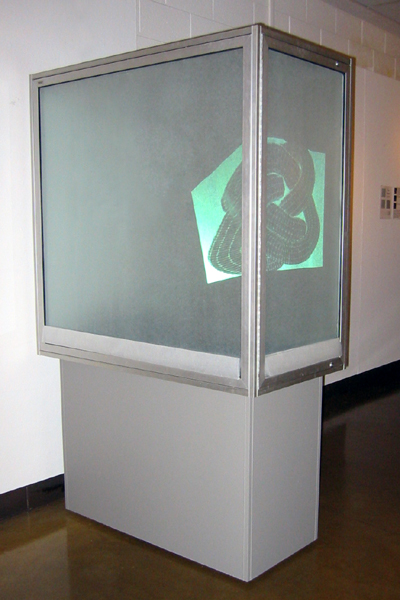Jason Cantarella and Michael Piatek
"Everything in its right place"
(photo of installation)
Mixed media, completed in 2004

"Everything in its right place"
(one still frame)

Jason Cantarella is an assistant professor of mathematics at the University of Georgia. His research is in differential geometry, with a particular focus on the geometry of curves. Cantarella received his Ph.D. from the University of Pennsylvania in 1999. He was an NSF Postdoctoral Fellow and a member of Project NeXT (gold dot).
Michael Piatek is an undergraduate student at Duquesne University in mathematics and computer science. His research interests include both computational knot theory and network problems. Piatek is a two-time winner of the ACM Undergraduate Student Research contest.
Cantarella and Piatek completed this work as part of the University of Georgia VIGRE program in Mathematics and Visualization during the summer of 2004.
"This experimental animation is trying to bring a more natural feel to the abstract, mechanical universe of computer graphics. Most animation is scripted by a human, with the interactions between objects either decided in advance or restricted to very simple collisions and bounces.
We built this artistic system to get closer to the way things happen in nature-- the flexible rope creates and destroys self-contacts as needed, and is capable of very complicated interactions between several pieces of the rope at the same time.
The same principles govern the shifting of pebbles underfoot when you step into a rock garden-- the force of your foot generates a network of contacts spreading from your footprint through the rocks in the garden, and every rock touched shifts slightly in response.
"The animation is based on our state-of-the-art knot tightening code RidgeRunner, which was originally designed to help answer questions like: What is the shortest length of rope needed to tie a knot? Our software is based on mathematical ideas from tensegrity theory. The rope feels an elastic force which draws it tighter. But at each timestep, the software builds a system of self-contacts between portions of the tube. Since the tube cannot overlap itself, these contacts cannot be compressed, and so the elastic force must be resolved against these constraints. The knot moves slightly in the direction of the resultant force, and the cycle starts again.
RidgeRunner is joint work with Eric Rawdon of Duquesne University, and some of the libraries used in the project are joint work with Ted Ashton of the University of Georgia."
Click here to download the
QuickTime movie (12 Mb) of this knot tightening. More knot-tightening movies are
available here.
Please email: jason@math.uga.edu for more information.
http://www.math.uga.edu/~cantarel



